1953 JEEP DJ oil type
[x] Cancel search: oil typePage 15 of 376
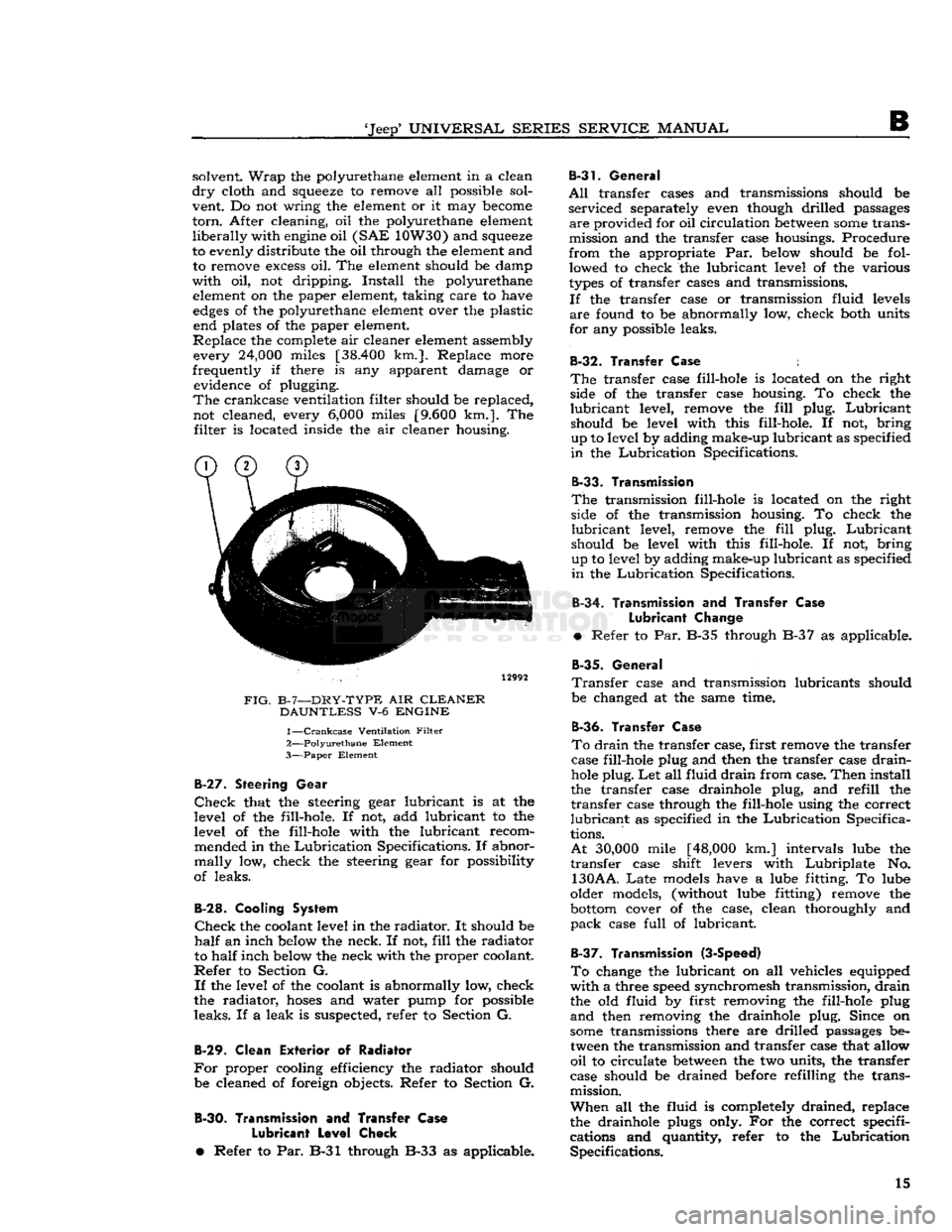
'Jeep*
UNIVERSAL SERIES SERVICE
MANUAL
B
solvent.
Wrap
the polyurethane element in a clean
dry
cloth and
squeeze
to remove all possible sol
vent. Do not wring the element or it may
become
torn.
After cleaning, oil the polyurethane element
liberally
with
engine
oil
(SAE
10W30) and
squeeze
to evenly distribute the oil through the element and to remove
excess
oil. The element should be damp
with
oil, not dripping.
Install
the polyurethane element on the paper element, taking care to have
edges
of the polyurethane element over the plastic end plates of the paper element.
Replace
the complete air cleaner element assembly every
24,000
miles
[38.400
km.]. Replace more
frequently if there is any apparent damage or evidence of plugging.
The
crankcase ventilation filter should be replaced, not cleaned, every
6,000
miles
[9.600
km.]. The
filter
is located inside the air cleaner housing.
12992
FIG.
B-7—DRY-TYPE
AIR
CLEANER DAUNTLESS
V-6
ENGINE
1—
Crankcase
Ventilation
Filter
2—
Polyurethane
Element
3—
Paper
Element
B-27.
Steering
Gear
Check
that the steering gear lubricant is at the
level of the fill-hole. If not, add lubricant to the
level of the fill-hole with the lubricant recom mended in the
Lubrication
Specifications. If abnor
mally
low, check the steering gear for possibility
of leaks.
B-28.
Cooling System
Check
the coolant level in the
radiator.
It should be
half
an inch below the neck. If not,
fill
the radiator
to
half
inch below the neck with the proper coolant.
Refer
to Section G.
If
the level of the coolant is abnormally low, check
the radiator,
hoses
and water pump for possible
leaks.
If a leak is suspected, refer to Section G.
B-29.
Clean
Exterior
of Radiator
For
proper cooling efficiency the radiator should be cleaned of foreign objects. Refer to Section G.
B-30.
Transmission
and
Transfer Case
Lubricant
Level
Cheek
•
Refer to Par. B-31 through B-33 as applicable.
B-31.
General
All
transfer cases and transmissions should be
serviced
separately even though drilled passages
are
provided for oil circulation
between
some
trans
mission and the transfer case housings. Procedure
from
the appropriate Par. below should be fol lowed to check the lubricant level of the various
types
of transfer cases and transmissions.
If
the transfer case or transmission fluid levels
are
found to be abnormally low, check both units
for any possible leaks.
B-32.
Transfer
Case
:
The
transfer case fill-hole is located on the right side of the transfer case housing. To check the
lubricant
level, remove the
fill
plug.
Lubricant
should be level with this fill-hole. If not, bring up to level by adding make-up lubricant as specified
in
the
Lubrication
Specifications.
B-33.
Transmission
The
transmission fill-hole is located on the right side of the transmission housing. To check the
lubricant
level, remove the
fill
plug.
Lubricant
should be level with this fill-hole. If not, bring
up to level by adding make-up
lubricant
as specified
in
the
Lubrication
Specifications.
B-34.
Transmission and Transfer
Case
Lubricant
Change
•
Refer to Par. B-35 through B-37 as applicable.
B-35.
General
Transfer
case and transmission lubricants should
be changed at the same time.
B-36.
Transfer
Case
To
drain
the transfer case, first remove the transfer
case fill-hole plug and then the transfer case
drain-
hole
plug. Let all fluid
drain
from case.
Then
install
the transfer case drainhole plug, and
refill
the
transfer
case through the fill-hole using the correct
lubricant
as specified in the
Lubrication
Specifica
tions.
At
30,000
mile
[48,000
km.] intervals lube the
transfer
case shift levers with
Lubriplate
No.
130AA.
Late
models have a lube fitting. To lube
older models, (without lube fitting) remove the
bottom
cover of the case, clean thoroughly and
pack
case
full
of lubricant.
B-37.
Transmission (3-Speed)
To
change the lubricant on all vehicles equipped
with
a three speed synchromesh transmission,
drain
the old fluid by first removing the fill-hole plug
and
then removing the drainhole plug. Since on
some
transmissions there are drilled passages be tween the transmission and transfer case that allow
oil
to circulate
between
the two units, the transfer
case should be drained before refilling the trans
mission.
When
all the fluid is completely drained, replace
the drainhole plugs only. For the correct specifi
cations and quantity, refer to the
Lubrication
Specifications. 15
Page 16 of 376
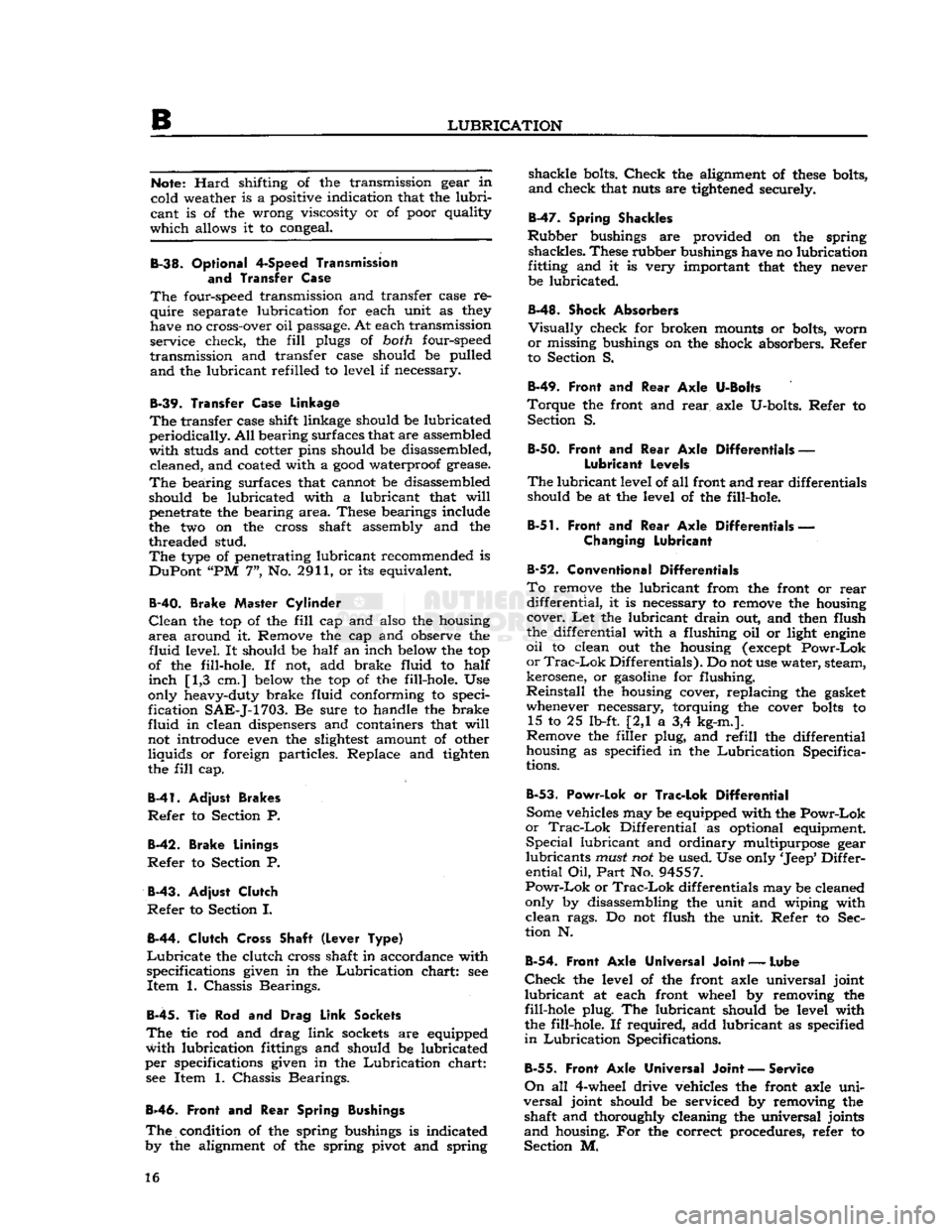
B
LUBRICATION
Note:
Hard
shifting of the transmission gear in
cold weather is a positive indication that the
lubri
cant
is of the wrong viscosity or of poor quality
which
allows it to congeal.
B-38.
Optional
4-Speed
Transmission
and
Transfer Case
The
four-speed transmission and transfer case re
quire
separate lubrication for each unit as
they
have no cross-over oil passage. At each transmission
service check, the
fill
plugs of
both
four-speed
transmission
and transfer case should be pulled
and
the lubricant refilled to level if necessary.
B-39.
Transfer
Case
Linkage
The
transfer case shift linkage should be lubricated
periodically.
All
bearing surfaces that are assembled
with
studs and cotter pins should be disassembled, cleaned, and coated with a
good
waterproof grease.
The
bearing surfaces that cannot be disassembled
should be lubricated with a lubricant that
will
penetrate the bearing
area.
These bearings include
the two on the cross shaft assembly and the
threaded stud.
The
type
of penetrating lubricant recommended is
DuPont
"PM 7", No. 2911, or its equivalent.
B-40.
Brake Master Cylinder
Clean
the top of the
fill
cap and also the housing
area
around it. Remove the cap and observe the
fluid
level. It should be
half
an inch
below
the top
of the fill-hole. If not, add brake fluid to
half
inch
[1,3 cm.]
below
the top of the fill-hole. Use
only heavy-duty brake fluid conforming to speci
fication
SAE-J-1703.
Be sure to handle the brake
fluid
in clean dispensers and containers that
will
not introduce even the
slightest
amount of other
liquids
or foreign particles. Replace and tighten
the
fill
cap.
B-41.
Adjust Brakes
Refer
to Section P.
B-42.
Brake Linings
Refer
to Section P.
B-43.
Adjust Clutch
Refer
to Section I.
B-44.
Clutch Cross Shaft (Lever Type)
Lubricate
the clutch cross shaft in accordance with
specifications given in the
Lubrication
chart: see
Item
1. Chassis Bearings.
B-45.
Tie Rod and Drag
Link
Sockets
The
tie rod and drag
link
sockets
are equipped
with
lubrication
fittings
and should be lubricated
per
specifications given in the
Lubrication
chart: see Item 1. Chassis Bearings.
B-46.
Front
and
Rear Spring
Bushings
The
condition of the spring bushings is indicated
by the alignment of the spring pivot and spring
shackle
bolts.
Check
the alignment of
these
bolts,
and
check that nuts are
tightened
securely.
B-47.
Spring
Shackles
Rubber
bushings are provided on the spring
shackles.
These rubber bushings have no lubrication
fitting and it is very important that
they
never be lubricated.
B-48.
Shock Absorbers
Visually
check for broken mounts or bolts, worn
or
missing bushings on the shock absorbers. Refer
to Section S.
B-49.
Front and
Rear
Axle
U-Bolts
Torque
the front and
rear
axle U-bolts. Refer to Section S.
B-50. Front
and
Rear
Axle
Differentials
—
Lubricant Levels
The
lubricant
level of all front and
rear
differentials should be at the level of the fill-hole.
B-51.
Front and
Rear
Axle
Differentials
—
Changing
Lubricant
B-52.
Conventional Differentials
To
remove the lubricant from the front or
rear
differential,
it is necessary to remove the housing cover. Let the lubricant
drain
out, and then flush
the differential with a flushing oil or light
engine
oil
to clean out the housing
(except
Powr-Lok
or
Trac-Lok
Differentials). Do not use water, steam,
kerosene, or
gasoline
for flushing.
Reinstall
the housing cover, replacing the gasket whenever necessary, torquing the cover
bolts
to 15 to 25 lb-ft. [2,1 a 3,4 kg-m.].
Remove the filler plug, and
refill
the differential
housing as specified in the
Lubrication
Specifica
tions.
B-53.
Powr-Lok
or
Trac-Lok Differential
Some vehicles may be equipped with the
Powr-Lok
or
Trac-Lok
Differential as optional equipment.
Special
lubricant and ordinary multipurpose gear
lubricants
must
not be used. Use only
'Jeep*
Differ
ential
Oil,
Part
No. 94557.
Powr-Lok
or
Trac-Lok
differentials may be cleaned
only by disassembling the unit and wiping with
clean
rags. Do not flush the unit. Refer to Sec
tion N.
B-54.
Front Axle Universal Joint
—
Lube
Check
the level of the front axle universal joint
lubricant
at each front wheel by removing the
fill-hole plug. The lubricant should be level with
the fill-hole. If required, add lubricant as specified
in
Lubrication
Specifications.
B-55.
Front
Axle
Universal
Joint
— Service
On
all 4-wheel drive vehicles the front axle
uni
versal
joint should be serviced by removing the shaft and thoroughly cleaning the universal joints
and
housing. For the correct procedures, refer to
Section M. 16
Page 17 of 376
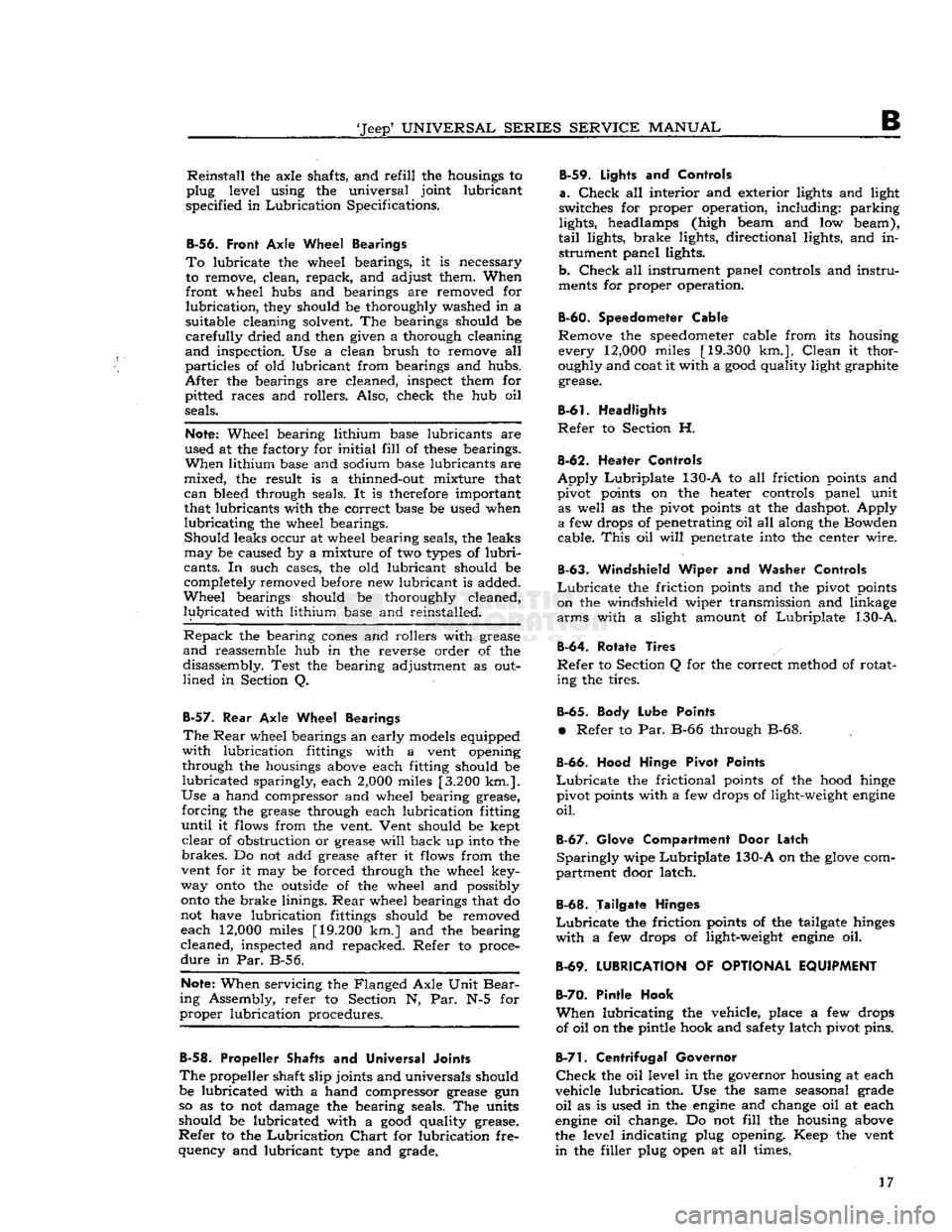
'Jeep'
UNIVERSAL SERIES SERVICE
MANUAL
B
Reinstall
the axle shafts, and
refill
the housings to
plug level using the universal joint lubricant
specified in
Lubrication
Specifications.
B-56.
Front
Axle Wheel Bearings
To
lubricate the wheel bearings, it is necessary
to remove, clean, repack, and adjust them. When
front wheel hubs and bearings are removed for
lubrication,
they should be thoroughly washed in a
suitable cleaning solvent. The bearings should be
carefully
dried and then given a thorough cleaning
and
inspection. Use a clean brush to remove all
particles
of old lubricant from bearings and hubs.
After
the bearings are cleaned, inspect them for
pitted races and rollers. Also, check the hub oil
seals.
Note:
Wheel bearing lithium base lubricants are
used at the factory for
initial
fill
of
these
bearings.
When
lithium base and sodium base lubricants are
mixed,
the result is a thinned-out mixture that
can
bleed through seals. It is therefore important
that lubricants with the correct base be used when
lubricating
the wheel bearings.
Should
leaks occur at wheel bearing seals, the leaks
may
be caused by a mixture of two
types
of
lubri
cants.
In such cases, the old lubricant should be
completely removed before new lubricant is added.
Wheel
bearings should be thoroughly cleaned,
lubricated
with lithium base and reinstalled.
Repack
the bearing
cones
and rollers with grease
and
reassemble hub in the reverse order of the
disassembly. Test the bearing adjustment as out
lined
in Section Q.
B-57.
Rear
Axle Wheel Bearings
The
Rear
wheel bearings an early models equipped
with
lubrication fittings with a vent opening
through the housings above each fitting should be
lubricated
sparingly, each
2,000
miles
[3.200
km.].
Use
a hand compressor and wheel bearing grease,
forcing
the grease through each lubrication fitting
until
it flows from the vent. Vent should be kept
clear
of obstruction or grease
will
back up into the
brakes.
Do not add grease after it flows from the
vent for it may be forced through the wheel key-
way
onto
the outside of the wheel and possibly
onto
the brake linings.
Rear
wheel bearings that do
not have lubrication fittings should be removed
each
12,000
miles
[19.200
km.] and the bearing
cleaned, inspected and repacked. Refer to proce
dure
in Par. B-56.
Note:
When servicing the Flanged Axle Unit
Bear
ing Assembly, refer to Section N, Par. N-5 for
proper
lubrication procedures.
B-58.
Propeller Shafts
and
Universal Joints
The
propeller shaft slip joints and universals should
be lubricated with a hand compressor grease gun so as to not damage the bearing seals. The units
should be lubricated with a
good
quality grease.
Refer
to the
Lubrication
Chart
for lubrication fre
quency and lubricant type and grade. B-59.
Lights
and
Controls
a.
Check
all interior and exterior lights and light
switches for proper operation, including: parking
lights, headlamps (high beam and low beam),
tail
lights, brake lights, directional lights, and in strument panel lights.
b.
Check
all instrument panel controls and
instru
ments for proper operation.
B-60.
Speedometer Cable
Remove the
speedometer
cable from its housing every
12,000
miles
[19.300
km.].
Clean
it thor
oughly and coat it with a
good
quality light graphite grease.
B-61.
Headlights
Refer
to Section H.
B-62.
Heater Controls
Apply
Lubriplate
130-A to all friction points and
pivot points on the heater controls panel unit as well as the pivot points at the dashpot. Apply
a
few drops of penetrating oil all along the Bowden
cable.
This
oil
will
penetrate into the center wire.
B-63.
Windshield Wiper and
Washer Controls
Lubricate
the friction points and the pivot points
on the windshield wiper transmission and linkage
arms
with a slight amount of
Lubriplate
130-A.
B-64.
Rotate Tires
Refer
to Section Q for the correct method of rotat ing the tires.
B-65.
Body Lube Points
•
Refer to Par. B-66 through B-68.
B-66.
Hood Hinge Pivot Points
Lubricate
the frictional points of the hood hinge
pivot points with a few drops of light-weight
engine
oil.
B-67.
Glove Compartment Door Latch
Sparingly
wipe
Lubriplate
130-A on the
glove
com
partment door latch.
B-68.
Tailgate Hinges
Lubricate
the friction points of the tailgate hinges
with
a few drops of light-weight
engine
oil.
B-69.
LUBRICATION
OF
OPTIONAL EQUIPMENT
B-70.
Pintle Hook
When
lubricating the vehicle, place a few drops of oil on the pintle hook and safety latch pivot pins.
B-7!.
Centrifugal Governor
Check
the oil level in the governor housing at each
vehicle lubrication. Use the same seasonal grade
oil
as is used in the
engine
and change oil at each
engine
oil change. Do not
fill
the housing above
the level indicating plug opening. Keep the vent
in
the filler plug open at all times. 17
Page 18 of 376
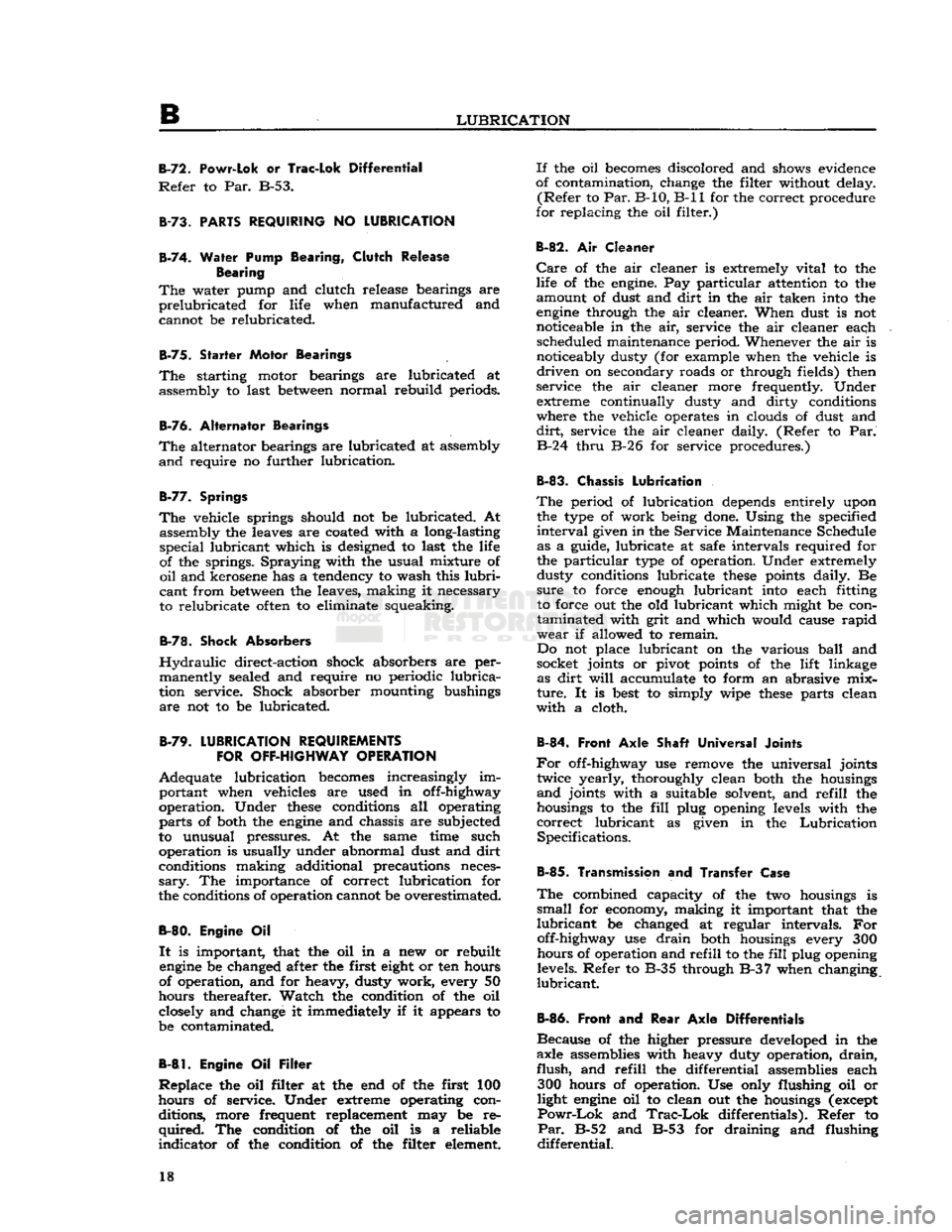
B
LUBRICATION
B-72.
Powr-Lok
or Trac-Lok
Differential
Refer
to Par. B-53.
B-73.
PARTS
REQUIRING
NO
LUBRICATION
B-74.
Water Pump Bearing,
Clutch
Release
Bearing
The
water pump and clutch release bearings are
prelubricated
for life when manufactured and cannot be relubricated.
B-7S.
Starter
Motor
Bearings
The
starting motor bearings are lubricated at assembly to last
between
normal rebuild periods.
B-76.
Alternator Bearings
The
alternator bearings are lubricated at assembly
and
require no further lubrication.
B-77.
Springs
The
vehicle springs should not be lubricated. At assembly the leaves are coated with a long-lasting
special
lubricant which is designed to last the life
of the springs. Spraying with the usual mixture of
oil
and kerosene has a tendency to wash this
lubri
cant
from
between
the leaves, making it necessary
to relubricate
often
to eliminate squeaking.
B-78.
Shock Absorbers
Hydraulic
direct-action shock absorbers are per manently sealed and require no periodic
lubrica
tion service. Shock absorber mounting bushings
are
not to be lubricated.
B-79.
LUBRICATION
REQUIREMENTS
FOR
OFF-HIGHWAY
OPERATION
Adequate lubrication
becomes
increasingly im portant when vehicles are used in off-highway
operation. Under
these
conditions all operating
parts
of both the
engine
and chassis are subjected
to unusual pressures. At the same time such operation is usually under abnormal dust and
dirt
conditions making additional precautions neces
sary.
The importance of correct lubrication for
the conditions of operation cannot be overestimated.
B-80.
Engine
Oil
It
is important, that the oil in a new or rebuilt
engine
be changed after the first
eight
or ten hours
of operation, and for heavy, dusty work, every 50
hours
thereafter. Watch the condition of the oil closely and change it immediately if it appears to
be contaminated.
i-Il.
Engine
Oil
Filter
Replace
the oil filter at the end of the first 100
hours
of service. Under extreme operating con ditions, more frequent replacement may be re
quired.
The condition of the oil is a reliable
indicator
of the condition of the filter element.
If
the oil
becomes
discolored and shows evidence
of contamination, change the filter without delay.
(Refer
to
Par.
B-10, B-ll for the correct procedure
for replacing the oil filter.)
B-82.
Air Cleaner
Care
of the air cleaner is extremely vital to the life of the engine. Pay particular attention to the
amount of dust and
dirt
in the air taken into the
engine
through the air cleaner. When dust is not
noticeable in the air, service the air cleaner each scheduled maintenance period. Whenever the air is
noticeably dusty (for example when the vehicle is
driven
on secondary roads or through fields) then
service the air cleaner more frequently. Under extreme continually dusty and dirty conditions
where the vehicle operates in clouds of dust and
dirt,
service the air cleaner daily. (Refer to Par.
B-24
thru
B-26 for service procedures.)
B-83.
Chassis
Lubrication
The
period of lubrication depends entirely upon the type of work being done. Using the specified
interval
given in the Service Maintenance Schedule as a guide, lubricate at safe intervals required for
the particular type of operation. Under extremely
dusty conditions lubricate
these
points daily. Be
sure
to force enough lubricant into each fitting to force out the old lubricant which might be con
taminated with grit and which would cause
rapid
wear
if allowed to remain.
Do not place lubricant on the various
ball
and socket joints or pivot points of the lift linkage as
dirt
will
accumulate to form an abrasive mix
ture.
It is
best
to simply wipe
these
parts clean
with
a cloth.
B-84.
Front
Axle
Shaft Universal Joints
For
off-highway use remove the universal joints twice yearly, thoroughly clean both the housings
and
joints with a suitable solvent, and
refill
the
housings to the
fill
plug opening levels with the
correct
lubricant as given in the
Lubrication
Specifications.
B-85.
Transmission and Transfer
Case
The
combined capacity of the two housings is
small
for economy, making it important that the
lubricant
be changed at regular intervals. For off-highway use
drain
both housings every 300
hours
of operation and
refill
to the
fill
plug opening
levels. Refer to B-35 through B-37 when changing
lubricant.
B-86.
Front and
Rear
Axle
Differentials
Because of the higher pressure developed in the
axle assemblies with heavy duty operation,
drain,
flush,
and
refill
the differential assemblies each 300 hours of operation. Use only flushing oil or light
engine
oil to clean out the housings (except
Powr-Lok
and
Trac-Lok
differentials). Refer to
Par.
B-52 and B-53 for draining and flushing
differential.
18
Page 44 of 376

D
HURRICANE
F4
ENGINE
Note:
Check
the condition of the rubber O-rings.
Defective O-rings could be the major cause of oil
leakage into cylinders. Always discard and replace
all
O-rings removed as only new O-rings should be installed at reassembly.
D-18.
Ream
Cylinder
Bore Ridges
To
prevent breaking the piston lands, the ridge
at the top of each cylinder bore must be removed
first.
To remove this ridge, use a cylinder ridge
reamer,
as shown in Fig. D-3 following the instruc
tions furnished by the reamer manufacturer. Use
care
not to cut below the top of the upper ring
travel
in the bore. Keep each piston top covered
with
an oil-soaked cloth to prevent cuttings from
falling
into the cylinder.
Note:
This
operation should be performed at this
time before the
engine
is rotated for the sequence
steps
following.
D-19.
Remove Oil Pan
Rotate the
engine
to the upside down position.
Remove the screws and lockwashers that attach
the oil pan to the cylinder block. Remove the oil
pan
and gasket.
Discard
the gasket.
D-20.
Remove Piston and Connecting
Rod
Assemblies
Remove the stamped locking nuts from the lower
end of each connecting rod bearing bolt. Remove
the connecting rod nuts. Remove the bearing cap evenly. Push the connecting rod and piston as
sembly out of the cylinder block with the handle end of a hammer until the piston rings are free from
the cylinder bore. Remove the piston and connecting rod assembly
from
the top of the cylinder block. Reassemble the
connecting rod bearing cap with the bearings in
place in the rod from which it was removed. Rotate
the crankshaft and follow the same procedure until
all
the piston and connecting rod assemblies are
removed.
Pistons and connecting rod assemblies may be removed for repair with the
engine
in the vehicle after draining the cooling system, removing the
oil
pan and the cylinder head, and reaming the ridges as previously described.
D-21.
Remove
Timing
Gear
Cover
Remove the bolts, nuts, and lockwashers, that at
tach
the timing gear cover to the engine. Remove
the cover, timing pointer, and cover gasket.
Dis
card
the gasket. Remove the crankshaft oil seal
from
the timing gear cover and discard the seal. Remove the oil slinger and spacer from the
crank
shaft.
D-22.
Remove
Timing
Gears
Use puller W-172 for pulling both the crankshaft
and
the camshaft gears.
With
the threaded cap-
screws supplied, adapt the puller to the crankshaft
FIG.
D-5—PULLING TIMING GEARS
1—
Puller
W-172 2—
Camshaft
Gear
gear and
pull
the gear.
With
the special hook-type
puller
bolts
that fit behind the camshaft gear
flange,
pull
the camshaft gear. Remove the Wood
ruff
Keys.
D-23.
Remove
Front
End Plate
Remove the screws and lockwashers that attach the
front end plate to the cylinder block. Remove the
front end plate and gasket.
Discard
the gasket.
D-24. Remove
Clutch
Remove four
bolts
and lockwashers diagonally
opposite
that attach the clutch assembly to the
flywheel, leaving two
opposed
bolts
to be
loosened
alternately until the clutch spring pressure is re
lieved.
Then,
support the clutch assembly with
one hand while removing the two remaining bolts.
For
information on disassembly, inspection, repair
and
assembly of the clutch refer to Section I. In
structions for removing the clutch when the
engine
is in the vehicle are also given in Section I.
D-25.
Remove Flywheel
The
flywheel is attached to the crankshaft with two tapered dowel
bolts
and four special bolts.
Remove
these
attaching parts. Use a pry bar be tween the flywheel and the back of the
engine
and
carefully
loosen
the flywheel from the crankshaft.
If
the flywheel is to be removed with the
engine
in
the vehicle, the transmission and clutch must
first be removed as detailed in Section I.
D-26.
Remove
Crankshaft
Slide
the crankshaft thrust washer and all end-play
adjusting
shims off the front end of the crankshaft.
Pull
the two pieces of
rear
main bearing cap packing out of position
between
the side of the bearing cap
and
the cylinder block.
Note
the marks on the bearing caps and cylinder
block for bearing number and position. 44
Page 45 of 376
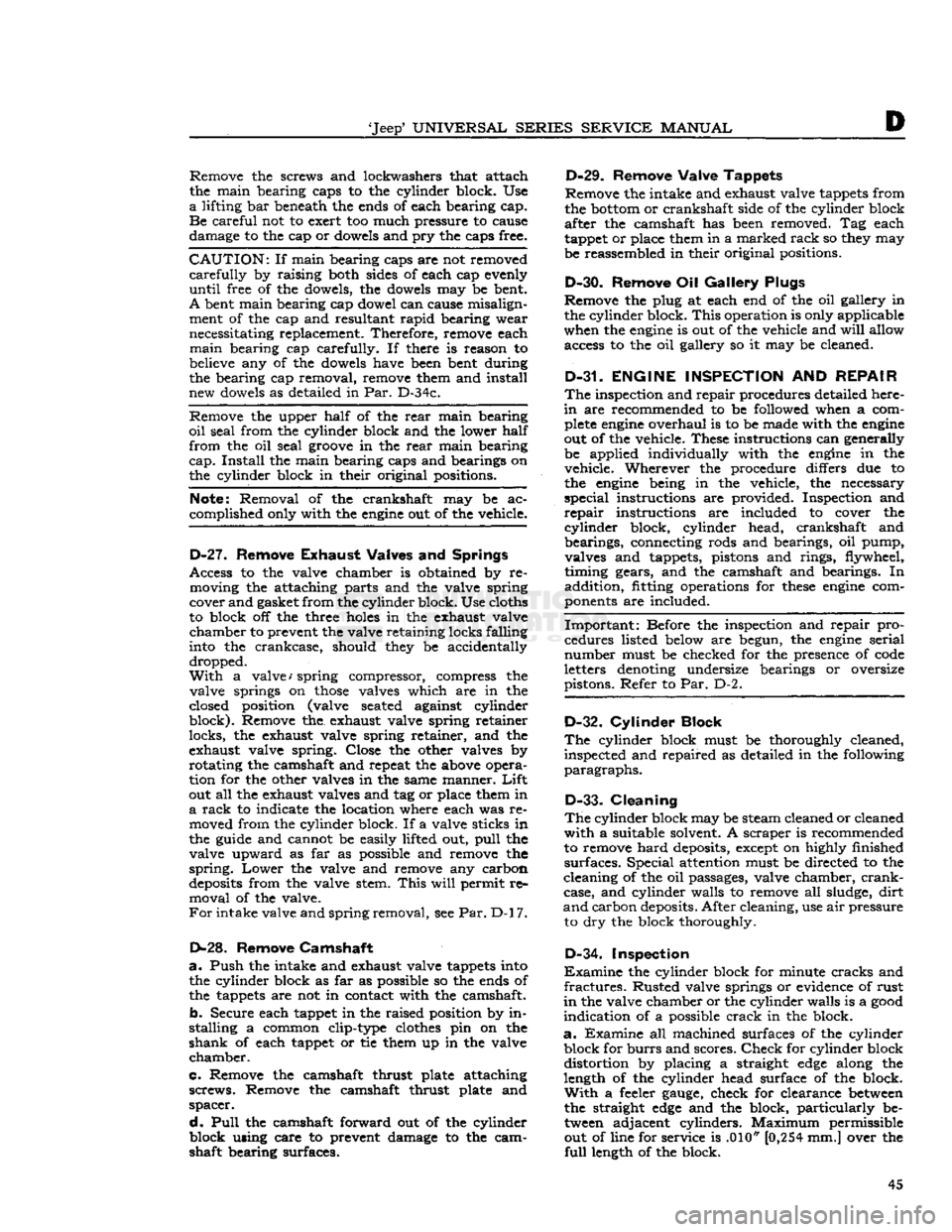
'Jeep'
UNIVERSAL SERIES SERVICE
MANUAL
D
Remove the screws and lockwashers that attach
the main bearing caps to the cylinder block. Use
a
lifting bar beneath the ends of each bearing cap.
Be
careful not to exert too much pressure to cause
damage to the cap or
dowels
and pry the caps free.
CAUTION:
If main bearing caps are not removed
carefully
by raising both sides of each cap evenly
until
free of the dowels, the
dowels
may be bent.
A
bent main bearing cap dowel can cause misalign ment of the cap and resultant
rapid
bearing wear
necessitating replacement. Therefore, remove each
main
bearing cap carefully. If there is reason to
believe any of the
dowels
have been bent during
the bearing cap removal, remove them and install
new
dowels
as detailed in Par. D-34c.
Remove the upper
half
of the
rear
main bearing
oil
seal from the cylinder block and the lower
half
from
the oil seal
groove
in the
rear
main bearing
cap.
Install
the main bearing caps and bearings on
the cylinder block in their original positions.
Note;
Removal of the crankshaft may be ac
complished only with the
engine
out of the vehicle.
D-27.
Remove
Exhaust
Valves and Springs
Access to the valve chamber is obtained by re moving the attaching parts and the valve spring
cover and gasket from the cylinder block. Use cloths
to block off the three
holes
in the exhaust valve
chamber to prevent the valve retaining locks falling
into the crankcase, should they be accidentally dropped.
With
a valve
/
spring compressor, compress the valve springs on
those
valves which are in the
closed position (valve seated against cylinder
block).
Remove the exhaust valve spring retainer
locks,
the exhaust valve spring retainer, and the exhaust valve spring. Close the other valves by
rotating the camshaft and repeat the above opera
tion for the other valves in the same manner.
Lift
out all the exhaust valves and tag or place them in
a
rack
to indicate the location where each was removed from the cylinder block. If a valve sticks in
the guide and cannot be easily lifted out,
pull
the valve upward as far as possible and remove the
spring.
Lower
the valve and remove any carbon
deposits
from the valve stem.
This
will
permit re moval of the valve.
For
intake valve and spring removal, see
Par.
D-l7.
D-28.
Remove Camshaft
a.
Push the intake and exhaust valve tappets into the cylinder block as far as possible so the ends of
the tappets are not in contact with the camshaft. b. Secure each tappet in the raised position by in
stalling a common clip-type clothes pin on the
shank
of each tappet or tie them up in the valve
chamber.
c. Remove the camshaft thrust plate attaching
screws.
Remove the camshaft thrust plate and
spacer.
d.
Pull
the camshaft forward out of the cylinder
block using care to prevent damage to the cam
shaft bearing surfaces.
D-29.
Remove Valve Tappets
Remove the intake and exhaust valve tappets from
the
bottom
or crankshaft side of the cylinder block
after the camshaft has been removed. Tag each
tappet or place them in a marked
rack
so they may be reassembled in their original positions.
D-30.
Remove Oil
Gallery
Plugs
Remove the plug at each end of the oil gallery in the cylinder block.
This
operation is only applicable
when the
engine
is out of the vehicle and
will
allow access to the oil gallery so it may be cleaned.
D-31. ENGINE INSPECTION
AND
REPAIR
The
inspection and repair procedures detailed here
in
are recommended to be followed when a com
plete
engine
overhaul is to be made with the
engine
out of the vehicle. These instructions can generally be applied individually with the
engine
in the
vehicle. Wherever the procedure differs due to
the
engine
being in the vehicle, the necessary
special
instructions are provided. Inspection and
repair
instructions are included to cover the
cylinder
block, cylinder head, crankshaft and bearings, connecting rods and bearings, oil pump, valves and tappets, pistons and rings, flywheel,
timing gears, and the camshaft and bearings. In addition, fitting operations for
these
engine
com
ponents
are included.
Important:
Before the inspection and repair pro
cedures listed below are begun, the
engine
serial
number must be checked for the presence of
code
letters denoting undersize bearings or oversize
pistons. Refer to Par. D-2.
D-32.
Cylinder
Block
The
cylinder block must be thoroughly cleaned, inspected and repaired as detailed in the following
paragraphs.
D-33.
Cleaning
The
cylinder block may be steam cleaned or cleaned
with
a suitable solvent. A scraper is recommended
to remove
hard
deposits, except on highly finished surfaces. Special attention must be directed to the
cleaning of the oil passages, valve chamber,
crank
case, and cylinder walls to remove all sludge,
dirt
and
carbon deposits. After cleaning, use air pressure to dry the block thoroughly.
D-34. Inspection
Examine
the cylinder block for minute cracks and
fractures.
Rusted valve springs or evidence of rust
in
the valve chamber or the cylinder walls is a
good
indication of a possible
crack
in the block,
a.
Examine all machined surfaces of the cylinder block for
burrs
and scores.
Check
for cylinder block
distortion by placing a straight
edge
along the
length of the cylinder head surface of the block.
With
a feeler
gauge,
check for clearance
between
the straight
edge
and the block, particularly be
tween adjacent cylinders. Maximum permissible
out of line for service is .010"
[0,254
mm.] over the
full
length of the block. 45
Page 47 of 376
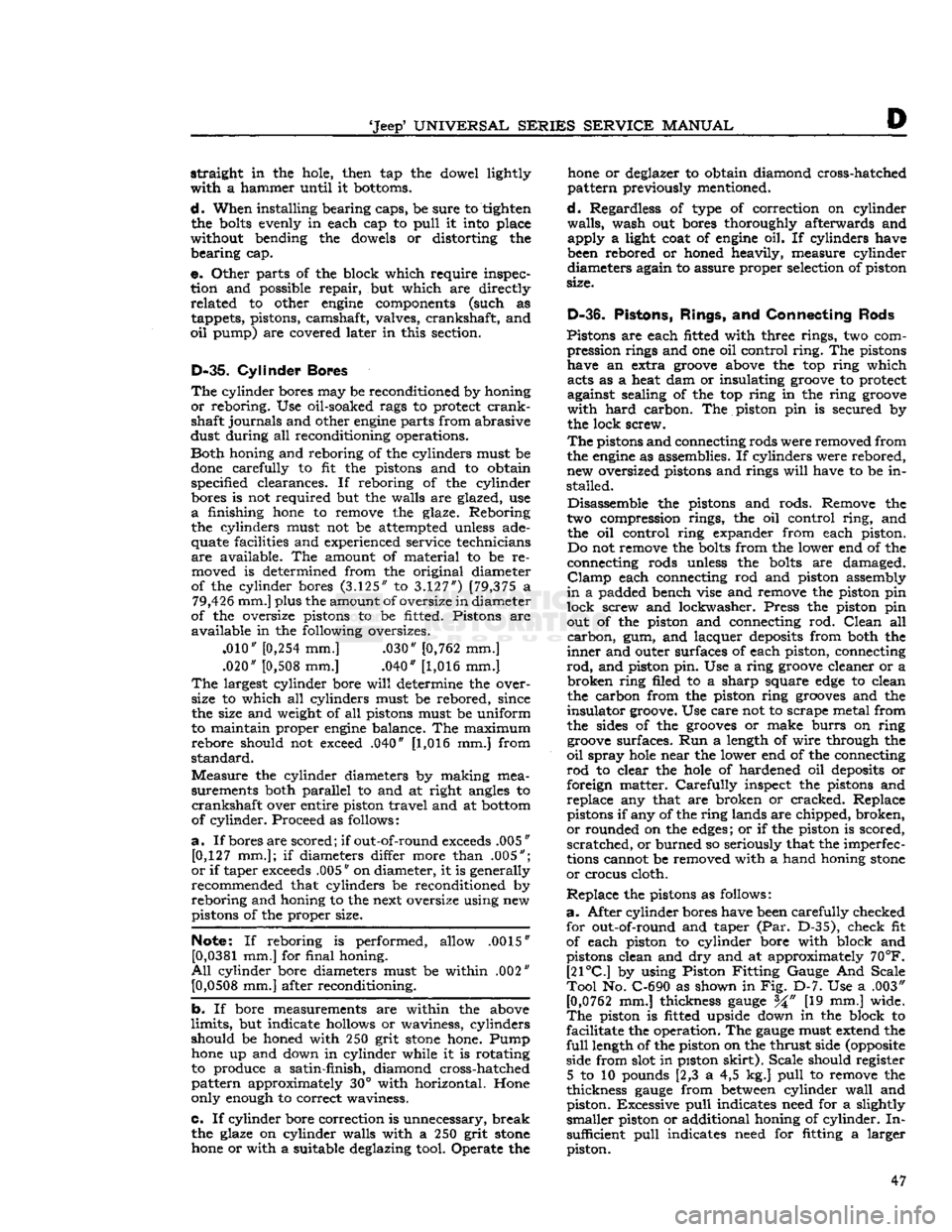
'Jeep*
UNIVERSAL
SERIES SERVICE
MANUAL
D
straight
in the hole, then tap the dowel lightly
with
a hammer until it
bottoms.
d.
When installing bearing eaps, be sure to tighten
the
bolts
evenly in each cap to
pull
it into place
without bending the
dowels
or distorting the
bearing
cap.
e. Other parts of the block which require inspec tion
and
possible
repair,
but which are directly
related
to other
engine
components (such as tappets, pistons, camshaft, valves, crankshaft, and
oil
pump) are covered later in this section.
D-35.
Cylinder
Bores
The
cylinder bores may be reconditioned by honing
or
reboring. Use oil-soaked rags to protect
crank
shaft
journals
and other
engine
parts from abrasive
dust during all reconditioning operations.
Both
honing and reboring of the cylinders must be
done
carefully to fit the pistons and to obtain
specified clearances. If reboring of the cylinder bores is not required but the walls are glazed, use
a
finishing
hone
to remove the glaze. Reboring the cylinders must not be attempted unless ade
quate facilities and experienced service technicians
are
available. The amount of material to be removed is determined from the original diameter
of the cylinder bores (3.125" to 3.127") [79,375 a
79,426
mm.] plus the amount of oversize in diameter
of the oversize pistons to be fitted. Pistons are
available
in the following oversizes.
.010"
[0,254
mm.] .030" [0,762 mm.] .020" [0,508 mm.] .040" [1,016 mm.}
The
largest cylinder bore
will
determine the over
size to which all cylinders must be rebored, since the size and weight of all pistons must be uniform
to maintain proper
engine
balance. The maximum rebore should not exceed .040" [1,016 mm.] from
standard.
Measure
the cylinder diameters by making mea
surements both parallel to and at right angles to
crankshaft
over entire piston travel and at
bottom
of cylinder. Proceed as follows:
a.
If bores are scored; if out-of-round
exceeds
.005
"
[0,127 mm.]; if diameters differ more than .005";
or
if taper
exceeds
.005
"
on diameter, it is generally
recommended that cylinders be reconditioned by
reboring
and honing to the next oversize using new
pistons of the proper size.
Note:
If reboring is performed, allow .0015"
[0,0381
mm.] for final honing.
All
cylinder bore diameters must be within .002
"
[0,0508
mm.] after reconditioning.
b.
If bore measurements are within the above
limits,
but indicate hollows or waviness, cylinders should be honed with 250 grit
stone
hone. Pump
hone
up and down in cylinder while it is rotating
to produce a satin-finish, diamond cross-hatched
pattern
approximately 30° with horizontal. Hone
only enough to correct waviness.
c. If cylinder bore correction is unnecessary, break the glaze on cylinder walls with a 250 grit
stone
hone
or with a suitable deglazing tool. Operate the
hone
or deglazer to obtain diamond cross-hatched
pattern
previously mentioned.
d.
Regardless of type of correction on cylinder
walls,
wash out bores thoroughly afterwards and
apply
a light coat of
engine
oil. If cylinders have
been rebored or honed heavily, measure cylinder
diameters again to assure proper selection of piston
size.
D-36.
Pistons, Rings, and Connecting Rods
Pistons are each fitted with three rings, two com pression rings and one oil control
ring.
The pistons have an extra
groove
above the top ring which acts as a heat dam or insulating
groove
to protect
against sealing of the top ring in the ring
groove
with
hard
carbon. The piston pin is secured by the lock screw.
The
pistons and connecting rods were removed from
the
engine
as assemblies. If cylinders were rebored,
new oversized pistons and rings
will
have to be in
stalled.
Disassemble the pistons and rods. Remove the
two compression rings, the oil control
ring,
and the oil control ring expander from each piston. Do not remove the
bolts
from the lower end of the
connecting rods unless the
bolts
are damaged.
Clamp
each connecting rod and piston assembly
in
a padded bench vise and remove the piston pin
lock
screw and lockwasher. Press the piston pin
out of the piston and connecting rod.
Clean
all
carbon,
gum, and lacquer
deposits
from both the
inner
and outer surfaces of each piston, connecting
rod,
and piston pin. Use a ring
groove
cleaner or a
broken
ring filed to a sharp square
edge
to clean
the carbon from the piston ring
grooves
and the
insulator
groove. Use care not to scrape metal from
the sides of the
grooves
or make
burrs
on ring
groove
surfaces. Run a length of wire through the
oil
spray
hole
near the lower end of the connecting
rod
to clear the
hole
of hardened oil
deposits
or
foreign matter.
Carefully
inspect the pistons and
replace
any that are broken or cracked. Replace
pistons if any of the ring lands are chipped, broken,
or
rounded on the
edges;
or if the piston is scored,
scratched,
or burned so seriously that the imperfec
tions cannot be removed with a hand honing
stone
or
crocus cloth.
Replace
the pistons as follows:
a.
After cylinder bores have been carefully checked for out-of-round and taper (Par. D-35), check fit
of each piston to cylinder bore with block and
pistons clean and dry and at approximately 70
°F.
[21°C]
by using Piston Fitting Gauge And Scale
Tool
No. C-690 as shown in Fig. D-7. Use a .003"
[0,0762
mm.] thickness
gauge
%" [19 mm.] wide.
The
piston is fitted upside down in the block to
facilitate the operation. The
gauge
must extend the
full
length of the piston on the thrust side
(opposite
side from slot in piston
skirt).
Scale should register
5
to 10 pounds [2,3 a 4,5 kg.]
pull
to remove the
thickness
gauge
from
between
cylinder
wall
and piston. Excessive
pull
indicates need for a slightly
smaller
piston or additional honing of cylinder. In sufficient
pull
indicates need for fitting a larger piston. 47
Page 49 of 376
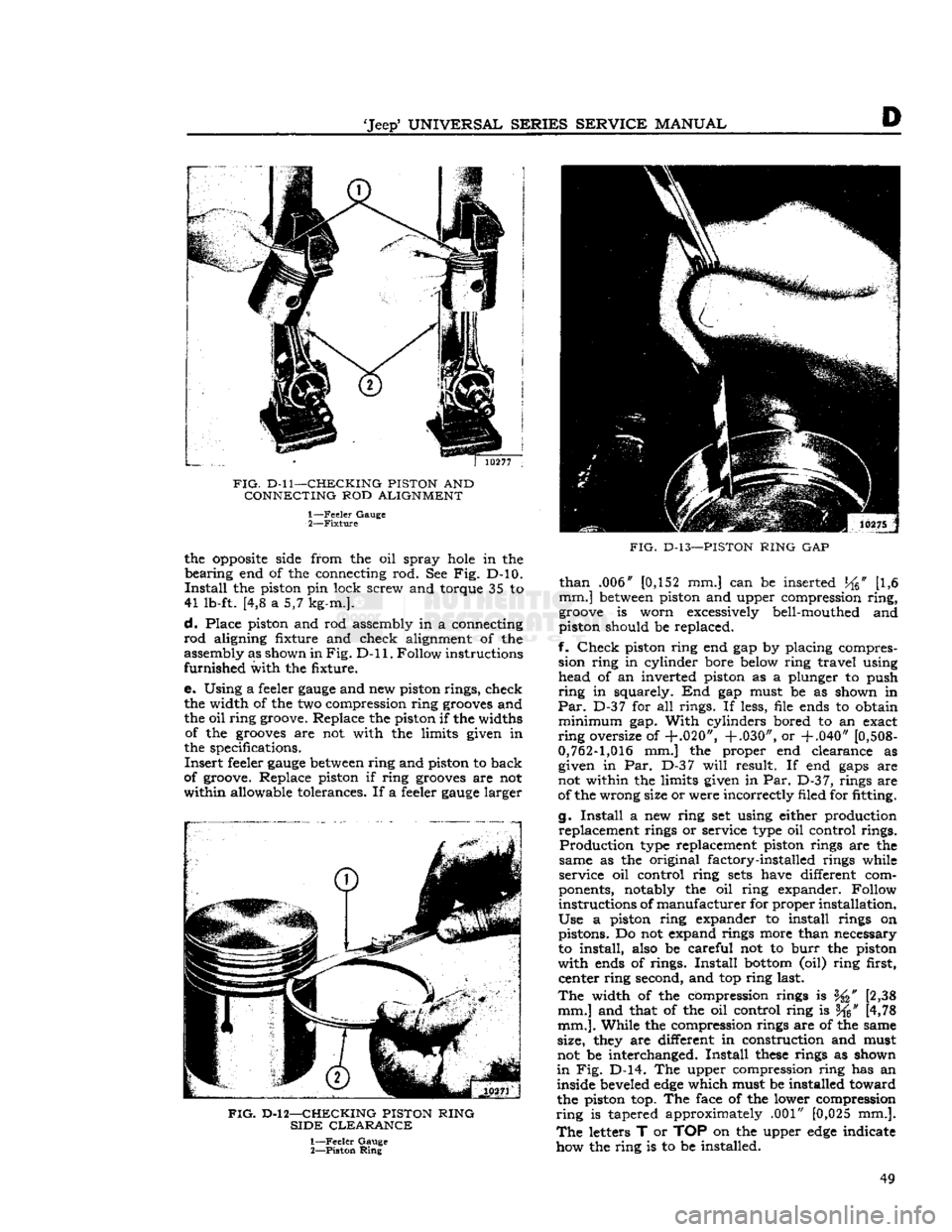
'Jeep'
UNIVERSAL SERIES
SERVICE
MANUAL
D
FIG.
D-ll—CHECKING PISTON
AND
CONNECTING
ROD
ALIGNMENT 1—
Feeler
Gauge
2—
Fixture
the
opposite
side from the oil spray
hole
in the
bearing
end of the connecting rod. See Fig. D-10.
Install
the piston pin lock screw and torque 35 to
41 lb-ft. [4,8 a 5,7 kg-m.].
d.
Place piston and rod assembly in a connecting
rod
aligning fixture and check alignment of the
assembly as shown in
Fig. D-ll.
Follow instructions
furnished
with the fixture.
e. Using a feeler
gauge
and new piston rings, check the width of the two compression ring
grooves
and
the oil ring groove. Replace the piston if the widths of the
grooves
are not with the limits given in
the specifications.
Insert
feeler
gauge
between
ring and piston to back
of groove. Replace piston if ring
grooves
are not
within
allowable tolerances. If a feeler
gauge
larger
FIG.
D-l 2—CHECKING PISTON RING
SIDE
CLEARANCE
1—
Feeler
Gauge
2—
Piston
Ring
FIG.
D-13—PISTON
RING
GAP
than
.006" [0,152 mm.] can be inserted
J^6"
[1,6
mm.]
between
piston and upper compression
ring,
groove
is worn excessively bell-mouthed and
piston should be replaced.
f.
Check
piston ring end gap by placing compres sion ring in cylinder bore below ring travel using head of an inverted piston as a plunger to push
ring
in squarely. End gap must be as shown in
Par.
D-37 for all rings. If less, file ends to obtain
minimum
gap.
With
cylinders bored to an exact
ring
oversize of
+.020", +.030",
or
+.040"
[0,508-
0,762-1,016
mm.] the proper end clearance as given in Par. D-37
will
result. If end
gaps
are
not within the limits given in Par.
D-3
7, rings are
of the wrong size or were incorrectly filed for fitting.
g.
Install
a new ring set using either production replacement rings or service type oil control rings.
Production
type replacement piston rings are the
same as the original factory-installed rings while
service oil control ring
sets
have different com
ponents, notably the oil ring expander. Follow
instructions of
manufacturer
for proper installation.
Use
a piston ring expander to install rings on pistons. Do not expand rings more than necessary
to install, also be careful not to
burr
the piston
with
ends of rings.
Install
bottom
(oil) ring first, center ring second, and top ring last.
The
width of the compression rings is [2,38
mm.] and that of the oil control ring is f^" [4,78
mm.].
While the compression rings are of the same
size, they are different in construction and must
not be interchanged.
Install
these
rings as shown
in
Fig. D-14. The upper compression ring has an
inside beveled
edge
which must be installed toward
the piston top. The face of the lower compression
ring
is tapered approximately .001" [0,025 mm.].
The
letters T or TOP on the upper
edge
indicate
how the ring is to be installed. 49